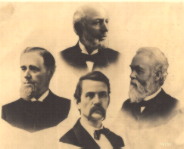
Big Four in action
The Big Four was a big tractor.
Named for its massive
four-cylinder engine, the Big Four traces its family history to the first
years of the twentieth century when D.M. Hartsough, one of the fledging
tractor industry's pioneer innovators, experimented with a multi-cylinder
engine. The new design sparked the interest of Patrick Lyons who, along
with Hartsough, organized the Transit Thresher Company to build an
improved version of the tractor.
The new company's name reflected
the organizers' idea of moving the tractor and threshing machine around a
stooked field instead of hauling stooks to the thresher.
"The machine travels over the field, picks up the bundles from the shocks
and does the threshing as it proceeds across the field. Those who have
witnessed the working of the machine claim that it will revolutionize
threshing in this country..." However,
this idea did not fly so in 1908 the name was changed to Gas Traction
Company.
For the first couple of years the factory was located in
Minneapolis, Minnesota. By 1910, the company made arrangements for
Canadian production as well. According to Gas Power Age, ..."this tractor
is now being built by the O'Grady Anderson Company of Winnipeg who have
just completed the erection of a fine new factory building...The first Gas
Traction [engine] built in Canada was recently completed and loaded at
Winnipeg." The
company had big plans with the factory reported to have a production
capacity of 600 tractors per year, beginning with an estimated 250 in
1910.
The Gas Traction Company advertised throughout western
Canada. Apparently, sales were good to farmers looking to break large
tracts of land. A gold medal and sweepstakes win at the 1910 Winnipeg
Agricultural Motor Competition was "a triumph which brought the Big Four
30 into still greater prominence throughout the United States and
Canada..."
One of the features of the Big Four was its "...steering device
which automatically guides the engine, keeping its course absolutely
parallel with the last furrow turned over." This was
an asset to farmers plowing mile-long furrows. "With this device, it is
only necessary for the operator to start the engine in the furrow at one
end of the field and to turn it when it reaches the other end; the
automatic steering device does all the rest." Today,
nearly 100 years later, similar claims are made, albeit with different
technology, for GPS systems which guide modern tractors and combines in
the fields. The Big Four's "steering device consists of a small pilot
wheel which runs along in the furrow ahead of the engine and is connected
with the front axle." Klaas
Peters, a farmer from Waldeck, SK wrote, "The steering attachment is worth
$5.00 every day I plow. Saves the wages of one man and steers the engine
better than any man could do."
The
Gas Traction Company also promoted the Hansmann binder hitch which made it
possible for one tractor to pull several binders. To owners with big
farms, this was important. Photographs showing one Big Four pulling up to
six binders were used in company advertising. The Big Four could also pull
multiple plows or harrows. William D. Mansell of Hanley, SK reported, "We
first seeded 1,000 acres with it, pulling four seeders and harrows behind.
We can plow as high as 25 acres stubble in 14 hours."
A
few big operators bought more than one Big Four. Fred Engen, who had large
land holdings a few miles east of Saskatoon and another large spread in
the Rosetown-Herschel area, reportedly had six of them. A farm in the
Young, SK area had five. The Weitzen farm south of Rosetown also had
several.
The Big Four, like other huge tractors in its time, flourished for
a relatively brief period. As millions of acres of prairie were broken,
demand for this kind of tractor diminished. Smaller, more maneuverable,
more affordable models began to take their place. The company was bought
out by Emerson-Brantingham of Rockford, Illinois in 1912. Production
continued until about 1920.
The Western Development Museum has two
Big Fours in its collection. One is in the machinery line-up at the
Saskatoon WDM. It was acquired by the WDM in 1948 from George Klassen of
Gronlid, SK. According to museum records, it began its working life on the
Keating farm in the Rosetown area about 1911. Keating sold it about eight
years later. A subsequent owner moved it to the St. Louis area where it
plowed brush land and powered a threshing machine. It ended up at Gronlid
providing power for a sawmill.
The WDM's second Big Four is at the North Battleford WDM. Little
is known of its history other than it was used in the southwest part of
the province near Shaunavon.
By Collections Curator Ruth Bitner
April
2008

Big Four


